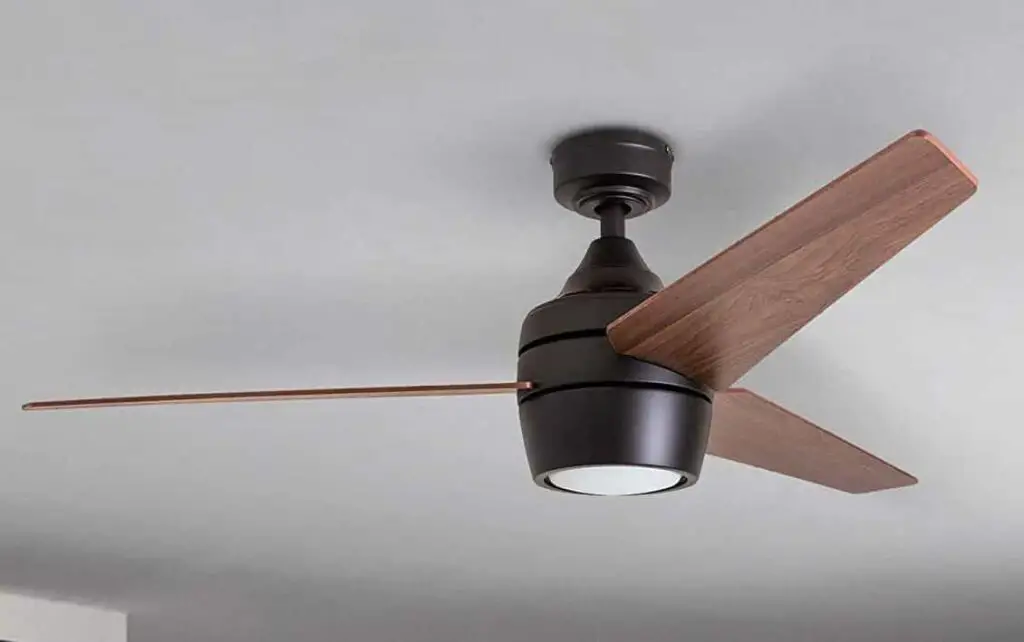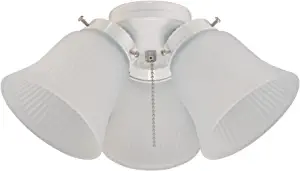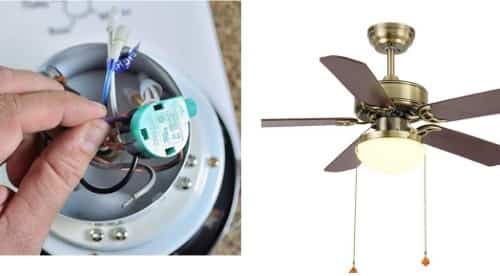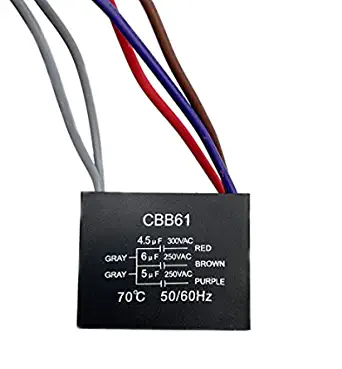Your ceiling fan light acting up? It can be seriously annoying. You hit the wall switch, and… nothing. The room stays dark. But don’t worry, in this post, we’re going to get to the bottom of why your ceiling fan light isn’t working. Whether it’s a fan motor refusing to spin or stubborn ceiling fan light bulbs, we’ve got your back.

Picture this: You’re under your ceiling fan, pull the chain, and… silence. Confused? It’s time to inspect the wires and that enigmatic switch housing.
But what if it’s not the fan itself? Maybe it’s a wonky light switch or a busted light bulb socket. And watch out for the circuit breaker; it might just need a reset.
In this guide, we’ll uncover the usual suspects behind a non-working ceiling fan light. We’ll walk you through checking the wires and looking for any damage. We’ll also show you how to use a voltage tester and give your ceiling fan a new lease on life with the right ceiling fan light kit.
Ready to bring light back into your life and get your fan blades spinning again? Let’s get started!
When Your Ceiling Fan Light Stops Working
Ceiling fan issues can be quite frustrating, and when your fan’s light stops working, it’s important to address the problem promptly. Let’s break down the common issues that could be causing this inconvenience.
1. Electrical Issues:
One of the first things to check when your ceiling fan light isn’t working is the wiring. Inspect the connections, particularly the black wires. Burn marks or loose connections can disrupt the flow of electricity.
It’s possible that a tripped circuit breaker might be the cause of your ceiling fan light malfunction. Check your electrical panel to see if any breakers have tripped, and reset them if needed.
If you have a voltage tester handy, use it to ensure that the power is reaching the fan’s light socket. If there’s no power, it’s time to investigate further.
2. Fan Motor Issues:
If your fan’s motor is working, but the blades won’t spin, it could be due to a malfunction in the motor itself. This can impact the entire fan’s operation, including the light.
3. Light Kit Issues:
The problem might be within the light kit itself. Check for loose connections and make sure the light bulbs are securely screwed in.

Sometimes, a simple issue like a faulty light bulb socket can cause the light to stop working. Replace any damaged sockets to see if that solves the problem.
4. Remote and Wall Switch Issues:
If you control your fan and light with a remote, it’s possible that the remote needs new batteries or has malfunctioned. Try changing the batteries or using the wall switch as an alternative control method.
The wall switch that controls the fan and light might be the source of the problem. Ensure it’s turned on and functioning correctly.
5. Pull Chain and Fan Speed Control:
If your ceiling fan has a pull chain for the light, make sure it’s not stuck or broken. These chains can wear out over time, causing the light to stop working.

Fan speed control not working can be another issue. Make sure it’s set to an appropriate speed and not in between settings, which can sometimes affect the light’s functionality.
But there’s more. If your fan won’t start or starts wobbling like it’s dancing solo, the capacitor’s the suspect, playing conductor for chaos.

The fix? Swap out that capacitor. It’s like hitting reset, taming your fan’s wild antics, making it purr like a well-oiled engine.
6. Unusual Noises and Wobbly Fan:
If your ceiling fan is making unusual noises, it might indicate a problem with the motor or the fan blades. A noisy fan could eventually lead to other issues, including the light not working.
A wobbly fan can also disrupt the electrical connections. It’s essential to secure the fan properly to prevent further damage.
7. Ceiling Fan Direction:
Although not directly related to the light, the direction in which your fan is spinning can affect its overall performance and longevity. Running the fan in the wrong direction could contribute to issues with both the fan and the light.
Now that we’ve identified the potential culprits causing your ceiling fan light to stop working let’s explore how to troubleshoot and fix these issues.
For detailed instructions on fixing non-functional ceiling fan lights, watch this informative video that provides step-by-step guidance for effective troubleshooting and issue resolution.
Troubleshooting Your Ceiling Fan Light
1. Begin by turning off the power to the fan at the circuit breaker to ensure safety. Carefully inspect the wiring connections, especially the black wires, for any signs of burn marks or loose connections. Tighten or replace any problematic wire nuts.
2. With the power turned back on, use a voltage tester to check if electricity is reaching the light socket. If there’s no power, consider consulting an electrician to address wiring issues.
3. If you discover that a circuit breaker has tripped, reset it. This simple step may resolve your ceiling fan light issue.
4. If the fan motor has power but the blades won’t spin, it’s advisable to contact a professional to diagnose and repair the motor issue. This type of repair is best left to experts.
5. Take a closer look at the light kit. Ensure that all the connections are secure and that the light bulbs are properly screwed in. If any parts appear damaged, consider replacing them.
6. Examine the light bulb socket for any signs of damage or corrosion. Replacing a faulty socket can often restore the functionality of your ceiling fan light.
7. If the remote isn’t working, replace the batteries and ensure it’s functioning correctly. If the wall switch is the problem, check the wiring and switch itself, and replace if necessary.
8. If you have a pull chain, ensure it’s not stuck or broken. If your fan has issues with speed control, adjust it to a different setting to see if that resolves the light problem.
9. To address noisy or wobbly fan issues, consider tightening all screws and making sure the fan is securely mounted. A wobbly fan can lead to electrical problems over time.
10. Ensure your ceiling fan is spinning in the right direction for the season. In the winter, fans should rotate clockwise to circulate warm air downwards. In the summer, they should rotate counterclockwise to create a cooling breeze.
Preventing Future Issues:
1. Once you’ve successfully resolved the problem with your ceiling fan light, it’s essential to take steps to prevent future malfunctions. Regular maintenance can go a long way in keeping your ceiling fan and light in optimal condition.
2. Dust and debris can accumulate on your fan’s blades and in the light kit. Regularly clean your fan to prevent these particles from affecting its performance.
3. Periodically check and tighten any screws or bolts in your fan. Loose components can contribute to wobbling and electrical issues.
4. When a light bulb burns out, replace it promptly. Using the right type of bulbs, as specified in your fan’s manual, is crucial.
5. If your fan is remote-controlled, change the batteries in the remote as needed. A weak battery can lead to unreliable performance.
6. Every year or so, consider having a professional technician inspect and service your ceiling fan. They can identify and address potential issues before they become major problems.
By following these maintenance tips, you can extend the life of your ceiling fan and enjoy consistent, hassle-free performance.
FAQs About Ceiling Fan Light Not Working
Why does my ceiling fan work but not the light?
Start by checking if the light bulb is burnt out or loose. If the bulb is okay, examine the light socket and the wiring that links the light to the fan. Make sure the light switch isn’t turned off or that you’re using the right control, as some fans have separate controls for the fan and light. If all else fails, get an electrician to look into any complex electrical issues.
How do I know if my ceiling fan capacitor is bad?
If your fan sticks to one speed, doesn’t adjust, or produces unusual humming sounds without turning, the capacitor might be the culprit. When your fan won’t start or wobbles excessively, it’s another indicator of a potential capacitor problem. Replacing the capacitor could solve these issues, but it’s wise to have an electrician inspect and replace it for you.
Why is the light not working on my Hampton fan?
Start by checking the light bulb; it might be burned out or not screwed in properly. Ensure the connections and wiring between the light and the fan are secure. Confirm that the light switch or remote control for the light is set to the “on” position. Remember, the fan and light may have separate controls. If these checks don’t solve the problem, there could be a more complex electrical issue.
What would cause a ceiling fan to suddenly stop working?
A ceiling fan can suddenly stop working for various reasons. This might be due to a blown fuse or tripped circuit breaker, loose or disconnected wires, a malfunctioning motor, or issues with the remote control or wall switch. In some cases, the fan might shut down to prevent overheating for safety. To pinpoint the cause and fix it, start by checking the power supply and then examine the fan’s wiring and components.
How do you fix a light switch on a ceiling fan?
Remove the cover of the fan’s light kit to access the switch. Make sure all wires are securely connected. If the switch is broken, replace it. Disconnect the wires, remove the old switch, and install a new one following the manufacturer’s instructions. Put the fan back together, restore power, and test the light to ensure it works.
What happens if capacitor fails in ceiling fan?
The fan may not work at all or may struggle to start, often making a humming sound. Speed control may become erratic, and the fan could run at a constant speed. In some cases, a failing capacitor can overheat the fan motor, causing potential damage. To fix this issue, you should replace the faulty capacitor with a new one to get your fan working correctly again.
Conclusion on Ceiling Fan Light Not Working
Once you read this guide, you’ll have the knowledge to solve the issue and bring back the light. We’ll decode the ceiling fan light kit, master wire nuts, and handle the pull chain.
We’ll highlight the importance of a voltage tester and expose the secrets of those plain black wires. Burn marks and broken connections, watch out – we’re on a mission, armed with know-how.
So, let’s get started. Flip that switch and join us in the quest to fix your ceiling fan light. Whether it’s a remote-control issue, a wall switch puzzle, or just dead light bulbs, this journey will lead you to a bright, peaceful space.